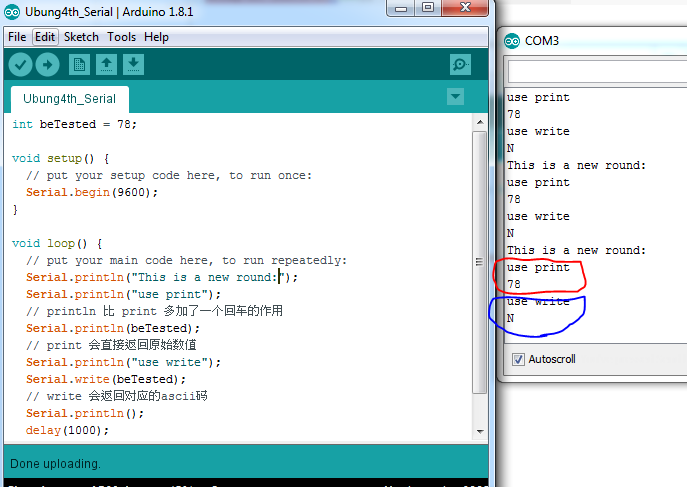
SERIAL PRINT ARDUINO INTEGER SERIAL
FAQs On Printing Data To Arduino Serial Monitor 1) What are AT commands?ĪT commands are attention commands used to interact with a co-processor. Serial.println() // carriage return after the last labelįor (int x = 0 x Learn more about How Easy Is It To Learn Arduino here. Serial.print("NO FORMAT") // prints a label Serial.begin(9600) // open the serial port at 9600 bps: Uses a for loop to print numbers in various formats.
SERIAL PRINT ARDUINO INTEGER CODE
Here is the code used to create the above pattern.

I encourage you to browse through all the examples once. I will show you various example projects of printing serial data in the following sections. Step-By-Step Instructions To Print Serial Data To Arduino If you click on the Clear Output button, the old messages you have printed onto the terminal will be cleared.Baud rate settings – You have to set this manually and match it with the baud rate you have set up in your Arduino sketch.

Arduino IDE picks the time from the computer. You can enable the timestamp option so that you can precisely see the time at which the messages were printed onto the terminal.If you enable Autoscroll, the text will automatically scroll up so that you can always see the latest message you have printed on the terminal.Serial monitor window where you see all the data you have printed to the terminal.Hit the Send button after entering the data in the text field.A text field where you can type the data you want to send to the Arduino.Serial COM port number to which the Arduino is connected.A PString class at arduiniana can build strings from stream inputs, if strings instead of streamed output are desired or needed.

Note, Streaming.h doesn't build any strings as such it just delivers the text of its <<-arguments to a stream. Which would keep the longer string in PROGMEM instead of bringing it into RAM. This could also be written as Serial << F("Your coordinates are ") << _FLOAT(latitude,3) << ", " << _FLOAT(longitude,4) << endl For example, to print latitude and longitude values in a form like "Your coordinates are -23.123, 135.4567” one could write: Serial << "Your coordinates are " << _FLOAT(latitude,3) << ", " << _FLOAT(longitude,4) << endl One can write Serial within sketches where you use << as a stream operator.īase-conversion specifiers _HEX, _DEC, _OCT, and _BIN are provided, as well as a _FLOAT function (with number of decimal places) and endl. Serial.print(" Var 3:") Serial.println(var3) Serial.print(" Var 2:") Serial.println(var2) Using Streaming.h, in place of Serial.print("Var 1:") Serial.println(var1) So I added ESP8266 mention and a printf wrapper for common AVR modules As mentioned, it's not available on most of the AVR modules. \n is the escape sequence for the line feed.Įscape sequences are used to represent certain special characters within string literals and character literals. More details about formatting tips on the printf format reference page : No need for additional library or function. Its built-in in Serial class of the framework.

Usage examples: p("Var 1:%s\nVar 2:%s\nVar 3:%s\n", var1, var2, var3) // strings Serial.print(buf) // Output result to Serial You can change the limit based on your requirements #include Ĭhar buf // resulting string limited to 128 chars The usage will depend of the data type of your variables. This is the function definition: #ifndef ARDPRINTFįor(i=0 str!='\0' i++) if(str='%') count++ Ĭase 'd': Serial.print(va_arg(argv, int)) Ĭase 'l': Serial.print(va_arg(argv, long)) Ĭase 'f': Serial.print(va_arg(argv, double)) Ĭase 'c': Serial.print((char)va_arg(argv, int)) Ĭase 's': Serial.print(va_arg(argv, char *)) It returns the number of arguments detected in the function call. The function prototype is: int ardprintf(char *. The output as expected is: test 2 123456789 g test 2.30 See it in action in this example:Īrdprintf("test %d %l %c %s %f", l, k, s, j, f) This function (given at the bottom) can be pasted in the beginning of the files where the function is needed. Ardprintf is a function that I hacked together which simulates printf over the serial connection.


 0 kommentar(er)
0 kommentar(er)
